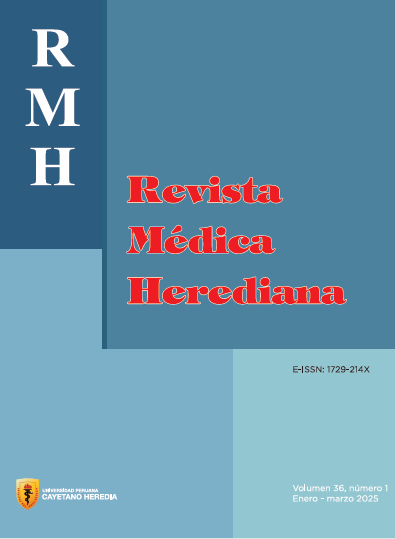Neurosurgical Management of a Giant Parasagittal Meningioma in a Patient with Neurofibromatosis Type 2: A Case Report
DOI:
https://doi.org/10.20453/rmh.v36i3.5841Palavras-chave:
Neurofibromatosis 2, Meningioma, Brain neoplasmsResumo
Parasagittal meningiomas are intracranial tumors that develop along the superior sagittal sinus. Although they are generally benign, their proximity to vital vascular structures poses significant challenges for surgical management. In patients with neurofibromatosis type 2 (NF2), an autosomal dominant genetic disorder, there is a high predisposition to develop multiple tumors in the central nervous system, including meningiomas and schwannomas. The report discusses a 23-year-old woman with a family history of NF2 who presented with a large parasagittal meningioma and bilateral schwannomas, along with symptoms such as headaches, hearing loss, vertigo, and seizures. MRI revealed a right frontoparietal meningioma invading the superior sagittal sinus. Successful craniotomy and resection showed a poorly vascularized meningioma invading the sagittal sinus. This case highlights the surgical difficulties associated with sagittal sinus meningioma invasion and emphasizes the importance of multidisciplinary care and long-term follow-up due to the high risk of tumor recurrence in NF2 patients.
Downloads
Referências
Pradilla G, Solero CL, Dimeco F. Parasagittal meningiomas. In: De Monte F, McDermott MW, Al-mefty O, editors. Al-mefty’s Meningiomas. 2nd ed. New York: Thieme; 2016. p. 145.
DiMeco F, Li KW, Casali C, Ciceri E, Giombini S, Filippini G, et al. Meningiomas invading the superior sagittal sinus: surgical experience in 108 cases. Neurosurgery. 2004;55(6):1263-72; discussion 1272-4. doi:10.1227/01.neu.0000143373.74160.f2.
Simpson D. The recurrence of the intracranial meningiomas after surgical treatment. J Neurol Neurosurg Psychiatry. 1957;20(1):22-39.
Evans DG. Neurofibromatosis type 2 (NF2): a clinical and molecular review. Orphanet J Rare Dis. 2009; 4:16. doi:10.1186/1750-1172-4-16.
Amaravathi A, Oblinger JL, Welling DB, Kinghorn AD, Chang LS. Neurofibromatosis: molecular pathogenesis and natural compounds as potential treatments. Front Oncol. 2021; 11:698192. doi:10.3389/fonc.2021.698192.
Chen WW, Wang Y, Hu YC, Zhao YL. Analysis of the common complications and recurrence-related factors of superior parasagittal sinus meningioma. Front Surg. 2023; 9:1023021. doi:10.3389/fsurg.2022.1023021.
Schmutzer M, Skrap B, Thorsteinsdottir J, Fürweger C, Muacevic A, Schichor C. Meningioma involving the superior sagittal sinus: long-term outcome after robotic radiosurgery in primary and recurrent situation. Front Oncol. 2023; 13:1206059. doi:10.3389/fonc.2023.1206059.
Plotkin SR, Merker VL, Muzikansky A, Barker FG 2nd, Slattery W 3rd. Natural history of vestibular schwannoma growth and hearing decline in newly diagnosed neurofibromatosis type 2 patients. Otol Neurotol. 2014; 35(1). doi:10.1097/MAO.0000000000000239.
Twomey JG, Bove C, Cassidy D. Presymptomatic genetic testing in children for neurofibromatosis 2. J Pediatr Nurs. 2008; 23(3):183-94. doi:10.1016/j.pedn.2006.11.002.
Casas Parera I, Báez A, Banfi N, Blumenkrantz Y, Halfon MJ, Barros M, et al. Meningiomas en neurooncología. Neurol argent. 2016;8(3):210-26. doi:10.1016/j.neuarg.2016.04.001.
Downloads
Publicado
Como Citar
Edição
Seção
Licença
Copyright (c) 2025 Luis Aguilar, Fritz Vascones, Yelimer Caucha

Este trabalho está licenciado sob uma licença Creative Commons Attribution 4.0 International License.
Os autores cedem os seus direitos à RMH para que estas possam divulgar o artigo através dos meios ao seu alcance. A revista fornecerá formulários de declaração de autoria e autorização para a publicação do artigo, que deverão ser entregues juntamente com o manuscrito. Os autores conservam o direito de partilhar, copiar, distribuir, executar e comunicar publicamente o seu artigo, ou parte dele, mencionando a publicação original na revista.




















